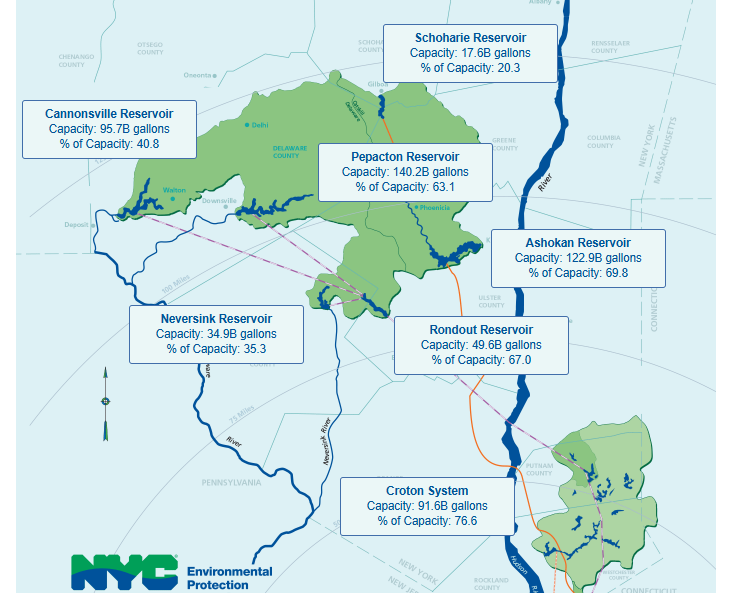
Delaware Aqueduct project on hold as drought complicates repairs
| November 19, 2024
The on-again-off-again-on-again long-awaited repairs to the leaking Delaware Aqueduct are off again – after having gotten started last month – because a prolonged lack of rain has meant that, during the project, the city has been drawing on now-depleted upstate New York reservoirs.
New York City Mayor Eric Adams made the announcement about the paused repairs on Monday as part of a broader rollout of water-conservation measures as the city notched its longest rainless streak in recorded history going back 155 years. Adams elevated the city to a drought warning, the first time since 2002.
That lack of rain — coupled with little in the forecast — complicated repairs to the leaking Delaware Aqueduct, an 86-mile pipeline that delivers half of the city’s water supply from the Catskills.
The repairs are now expected to resume next year, officials said.
The Delaware Aqueduct marries water from the three Delaware River reservoirs, Pepacton, Cannonsville and Neversink, at the Rondout Reservoir, carrying it under Ulster County, N.Y., and a small piece of Orange County, N.Y., to cross under the Hudson River and then to the expansive water distribution system north of the city.
The city’s Department of Environmental Protection planned to fix a massive leak (about 35 million gallons per day) under the Hudson. The leak has been a known problem for at least two decades.
That repair included the construction of a bypass tunnel — 2.5 miles long and about 600 feet below the Hudson River — to connect to the structurally sound portions of the Delaware Aqueduct. The aqueduct shutoff was required to allow the connection to the bypass, which has been completed.
With the Delaware Aqueduct in essence turned off, New York City was relying on water from other groups of reservoirs in the Catskills and Westchester and Putnam Counties.
In the long lead-up to the $2 billion repair project, which began on Oct. 1, flooding concerns persisted among upstate communities because those other reservoirs are so huge that if significant storms, such as a hurricane or tropical storm, dumped immense rainfall on them, they would overflow.
Instead, just the opposite has occurred as the dearth of rainfall meant that those reservoirs were being heavily taxed.
“The lack of rain upstate has meant that water reserves across all reservoirs are not where they need to be to complete the project in the spring,” the city said in a statement. “In the coming days, the city will begin the process of reopening the (Delaware) aqueduct to resume the flow of water from those reservoirs to New York City.”
At a news conference on Monday, Adams said the city’s reservoirs “are nowhere near where they should be.”
The city’s water supplies need nearly 8 inches of rain to return to normal levels, as Adams raised city’s footing to a drought warning — the second of three levels of water conservation declarations by the city.
“I want to be clear on this,” Adams added. “This is not normal. I am pretty sure that if you are outside, you are enjoying the beautiful weather in November but the reality is climate change is real and it has impacted our city.”
Meanwhile, the New York State Department of Environmental Conservation issued a heightened drought warning for much of the Catskills, Hudson Valley and New York City. The rest of the state remains under a drought watch.
A warning is the second of four levels of state drought advisories. The levels are: watch, warning, emergency and disaster).
The DEC said no statewide mandatory water use restrictions are in place under a drought watch or warning but residents are strongly encouraged to voluntarily conserve water.








